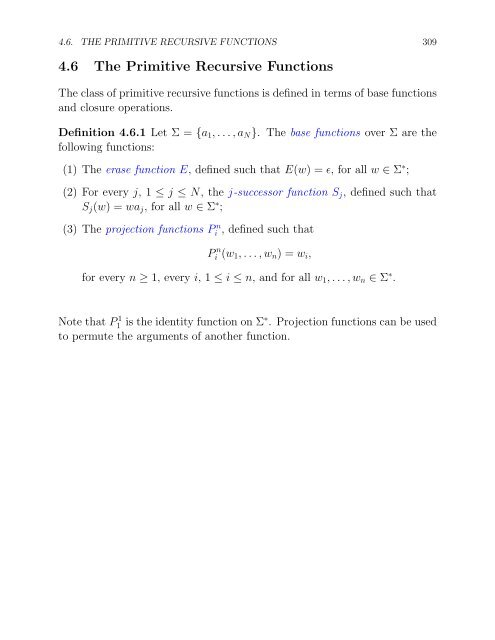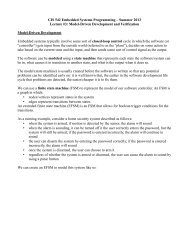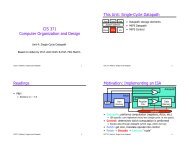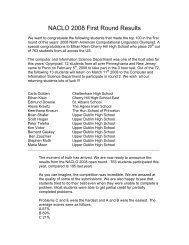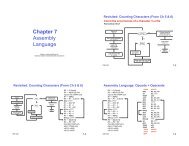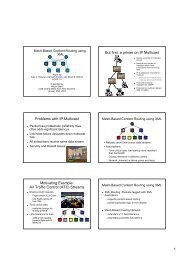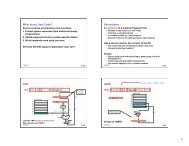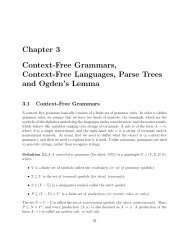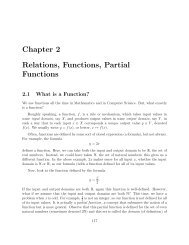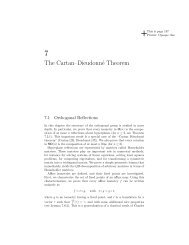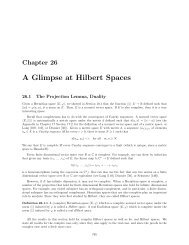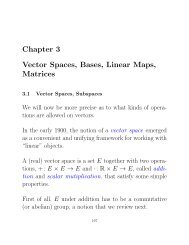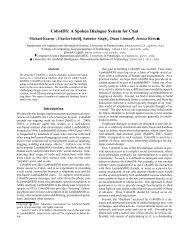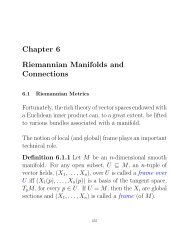4.6 The Primitive Recursive Functions
4.6 The Primitive Recursive Functions
4.6 The Primitive Recursive Functions
Create successful ePaper yourself
Turn your PDF publications into a flip-book with our unique Google optimized e-Paper software.
<strong>4.6</strong>. THE PRIMITIVE RECURSIVE FUNCTIONS 309<br />
<strong>4.6</strong> <strong>The</strong> <strong>Primitive</strong> <strong>Recursive</strong> <strong>Functions</strong><br />
<strong>The</strong> class of primitive recursive functions is defined in terms of base functions<br />
and closure operations.<br />
Definition <strong>4.6</strong>.1 Let Σ = {a 1 ,...,a N }. <strong>The</strong> base functions over Σ are the<br />
following functions:<br />
(1) <strong>The</strong> erase function E, defined such that E(w) =ɛ, for all w ∈ Σ ∗ ;<br />
(2) For every j, 1≤ j ≤ N, thej-successor function S j , defined such that<br />
S j (w) =wa j , for all w ∈ Σ ∗ ;<br />
(3) <strong>The</strong> projection functions Pi n , defined such that<br />
P n<br />
i (w 1 ,...,w n )=w i ,<br />
for every n ≥ 1, every i, 1≤ i ≤ n, andforallw 1 ,...,w n ∈ Σ ∗ .<br />
Note that P 1 1 is the identity function on Σ ∗ . Projection functions can be used<br />
to permute the arguments of another function.
310 CHAPTER 4. RAM PROGRAMS, TURING MACHINES<br />
A crucial closure operation is (extended) composition.<br />
Definition <strong>4.6</strong>.2 Let Σ = {a 1 ,...,a N }. For any function<br />
g:Σ<br />
} ∗ ×···×Σ<br />
{{ }<br />
∗ → Σ ∗ ,<br />
m<br />
and any m functions<br />
h i :Σ<br />
} ∗ ×···×Σ<br />
{{ }<br />
∗ → Σ ∗ ,<br />
n<br />
the composition of g and the h i is the function<br />
f:Σ<br />
} ∗ ×···×Σ<br />
{{ }<br />
∗ → Σ ∗ ,<br />
n<br />
denoted as g ◦ (h 1 ,...,h m ), such that<br />
f(w 1 ,...,w n )=g(h 1 (w 1 ,...,w n ),...,h m (w 1 ,...,w n )),<br />
for all w 1 ,...,w n ∈ Σ ∗ .<br />
As an example, f = g ◦ (P 2 2 ,P 2 1 ) is such that<br />
f(w 1 ,w 2 )=g(w 2 ,w 1 ).
<strong>4.6</strong>. THE PRIMITIVE RECURSIVE FUNCTIONS 311<br />
Another crucial closure operation is primitive recursion.<br />
Definition <strong>4.6</strong>.3 Let Σ = {a 1 ,...,a N }. For any function<br />
g:Σ<br />
} ∗ ×···×Σ<br />
{{ }<br />
∗ → Σ ∗ ,<br />
m−1<br />
where m ≥ 2, and any N functions<br />
h i :Σ<br />
} ∗ ×···×Σ<br />
{{ }<br />
∗ → Σ ∗ ,<br />
m+1<br />
the function<br />
f:Σ<br />
} ∗ ×···×Σ<br />
{{ }<br />
∗ → Σ ∗ ,<br />
m<br />
is defined by primitive recursion from g and h 1 ,...,h N ,if<br />
f(ɛ,w 2 ,...,w m )=g(w 2 ,...,w m ),<br />
f(ua 1 ,w 2 ,...,w m )=h 1 (u,f(u,w 2 ,...,w m ),w 2 ,...,w m ),<br />
...= ...<br />
f(ua N ,w 2 ,...,w m )=h N (u,f(u,w 2 ,...,w m ),w 2 ,...,w m ),<br />
for all u, w 2 ,...,w m ∈ Σ ∗ .
312 CHAPTER 4. RAM PROGRAMS, TURING MACHINES<br />
When m = 1, for some fixed w ∈ Σ ∗ ,wehave<br />
f(ɛ) =w,<br />
f(ua 1 )=h 1 (u,f(u)),<br />
...= ...<br />
f(ua N )=h N (u,f(u)),<br />
for all u ∈ Σ ∗ .<br />
For numerical functions (i.e., when Σ = {a 1 }), the scheme of primitive recursion<br />
is simpler:<br />
f(0,x 2 ,...,x m )=g(x 2 ,...,x m ),<br />
f(x +1,x 2 ,...,x m )=h 1 (x, f(x, x 2 ,...,x m ),x 2 ,...,x m ),<br />
for all x, x 2 ,...,x m ∈ N.
<strong>4.6</strong>. THE PRIMITIVE RECURSIVE FUNCTIONS 313<br />
<strong>The</strong> successor function S is the function<br />
S(x) =x +1.<br />
Addition, multiplication, exponentiation, and<br />
super-exponentiation can, be defined by primitive recursion as follows (being<br />
a bit loose, we should use some projections ...):<br />
add(0,n)=n,<br />
add(m +1,n)=S(add(m, n)),<br />
mult(0,n)=0,<br />
mult(m +1,n)=add(mult(m, n),n),<br />
rexp(0,m)=1,<br />
rexp(m +1,n)=mult(rexp(m, n),n),<br />
exp(m, n) =rexp ◦ (P2 2 ,P1 2 ),<br />
supexp(0,n)=1,<br />
supexp(m +1,n)=exp(n, supexp(m, n)).
314 CHAPTER 4. RAM PROGRAMS, TURING MACHINES<br />
As an example over {a, b} ∗ , the following function<br />
g:Σ ∗ × Σ ∗ → Σ ∗ , is defined by primitive recursion:<br />
g(ɛ, v) =P1 1 (v),<br />
g(ua i ,v)=S i ◦ P2 3 (u, g(u, v),v),<br />
where 1 ≤ i ≤ N. It is easily verified that g(u, v) =vu. <strong>The</strong>n,<br />
f = g ◦ (P 2 2 ,P 2 1 )<br />
computes the concatenation function, i.e. f(u, v) =uv.
<strong>4.6</strong>. THE PRIMITIVE RECURSIVE FUNCTIONS 315<br />
Definition <strong>4.6</strong>.4 Let Σ = {a 1 ,...,a N }. <strong>The</strong> class of primitive recursive<br />
functions is the smallest class of functions (over Σ ∗ ) which contains the base<br />
functions and is closed under composition and primitive recursion.<br />
We leave as an exercise to show that every primitive recursive function is<br />
a total function. <strong>The</strong> class of primitive recursive functions may not seem<br />
very big, but it contains all the total functions that we would ever want to<br />
compute.<br />
Although it is rather tedious to prove, the following theorem can be shown.
316 CHAPTER 4. RAM PROGRAMS, TURING MACHINES<br />
<strong>The</strong>orem <strong>4.6</strong>.5 For an alphabet Σ={a 1 ,...,a N }, every primitive recursive<br />
function is Turing computable.<br />
<strong>The</strong> best way to prove the above theorem is to use the computation model<br />
of RAM programs. Indeed, it was shown in <strong>The</strong>orem 4.4.1 that every Turing<br />
machine can simulate a RAM program.<br />
It is also rather easy to show that the primitive recursive functions are RAMcomputable.
<strong>4.6</strong>. THE PRIMITIVE RECURSIVE FUNCTIONS 317<br />
In order to define new functions it is also useful to use predicates.<br />
Definition <strong>4.6</strong>.6 An n-ary predicate P (over Σ ∗ ) is any subset of (Σ ∗ ) n .<br />
We write that a tuple (x 1 ,...,x n ) satisfies P as (x 1 ,...,x n ) ∈ P or as<br />
P (x 1 ,...,x n ). <strong>The</strong> characteristic function of a predicate P is the function<br />
C P :(Σ ∗ ) n →{a 1 } ∗ defined by<br />
{<br />
a1 iff P (x<br />
C p (x 1 ,...,x n )=<br />
1 ,...,x n )<br />
ɛ iff not P (x 1 ,...,x n ).<br />
A predicate P is primitive recursive iff its characteristic function C P is primitive<br />
recursive.<br />
We leave to the reader the obvious adaptation of the the notion of primitive<br />
recursive predicate to functions defined over N. In this case, 0 plays the role<br />
of ɛ and 1 plays the role of a 1 .
318 CHAPTER 4. RAM PROGRAMS, TURING MACHINES<br />
It is easily shown that if P and Q are primitive recursive predicates (over<br />
(Σ ∗ ) n ), then P ∨ Q, P ∧ Q and ¬P are also primitive recursive.<br />
As an exercise, the reader may want to prove that the predicate (defined over<br />
N):<br />
prime(n) iffn is a prime number, is a primitive recursive predicate.<br />
For any fixed k ≥ 1, the function:<br />
ord(k, n) = exponent of the kth prime in the prime factorization of n, isa<br />
primitive recursive function.<br />
We can also define functions by cases.
<strong>4.6</strong>. THE PRIMITIVE RECURSIVE FUNCTIONS 319<br />
Lemma <strong>4.6</strong>.7 If P 1 ,...,P n are pairwise disjoint primitive recursive predicates<br />
(which means that P i ∩ P j = ∅ for all i ≠ j) andf 1 ,...,f n+1 are<br />
primitive recursive functions, the function g defined below is also primitive<br />
recursive:<br />
⎧<br />
f 1 (x) iff P 1 (x)<br />
⎪⎨<br />
.<br />
g(x) =<br />
f ⎪⎩ n (x) iff P n (x)<br />
f n+1 (x) otherwise.<br />
(writing x for (x 1 ,...,x n ).)<br />
It is also useful to have bounded quantification and bounded minimization.
320 CHAPTER 4. RAM PROGRAMS, TURING MACHINES<br />
Definition <strong>4.6</strong>.8 If P is an (n+1)-ary predicate, then the bounded existential<br />
predicate ∃y/xP(y, z) holds iff some prefix y of x makes P (y, z) true.<br />
<strong>The</strong> bounded universal predicate ∀y/xP(y, z) holds iff every prefix y of x<br />
makes P (y, z) true.<br />
Lemma <strong>4.6</strong>.9 If P is an (n +1)-ary primitive recursive predicate, then<br />
∃y/xP(y, z) and ∀y/xP(y, z) are also primitive recursive predicates.<br />
As an application, we can show that the equality predicate, u = v?, is primitive<br />
recursive.
<strong>4.6</strong>. THE PRIMITIVE RECURSIVE FUNCTIONS 321<br />
Definition <strong>4.6</strong>.10 If P is an (n + 1)-ary predicate, then the bounded minimization<br />
of P ,miny/x P(y, z), is the function defined such that min y/x P(y, z)<br />
is the shortest prefix of x such that P (y, z) ifsuchay exists, xa 1 otherwise.<br />
<strong>The</strong> bounded maximization of P ,maxy/x P(y, z), is the function defined such<br />
that max y/x P(y, z) is the longest prefix of x such that P (y, z) ifsuchay<br />
exists, xa 1 otherwise.<br />
Lemma <strong>4.6</strong>.11 If P is an (n +1)-ary primitive recursive predicate, then<br />
min y/x P(y, z) and max y/x P(y, z) are primitive recursive functions.<br />
So far, the primitive recursive functions do not yield all the Turing-computable<br />
functions. In order to get a larger class of functions, we need the closure operation<br />
known as minimization.
322 CHAPTER 4. RAM PROGRAMS, TURING MACHINES<br />
4.7 <strong>The</strong> Partial <strong>Recursive</strong> <strong>Functions</strong><br />
<strong>The</strong> operation of minimization (sometimes called minimalization) is defined<br />
as follows.<br />
Definition 4.7.1 Let Σ = {a 1 ,...,a N }. For any function<br />
g:Σ<br />
} ∗ ×···×Σ<br />
{{ }<br />
∗ → Σ ∗ ,<br />
m+1<br />
where m ≥ 0, for every j, 1≤ j ≤ N, the function<br />
f:Σ<br />
} ∗ ×···×Σ<br />
{{ }<br />
∗ → Σ ∗ ,<br />
m<br />
is defined by minimization over {a j } ∗ from g, if the following conditions hold<br />
for all w 1 ,...,w m ∈ Σ ∗ :<br />
(1) f(w 1 ,...,w m ) is defined iff there is some n ≥ 0 such that<br />
g(a p j ,w 1,...,w m )isdefinedforallp, 0≤ p ≤ n, and<br />
g(a n j ,w 1 ,...,w m )=ɛ.
4.7. THE PARTIAL RECURSIVE FUNCTIONS 323<br />
(2) When f(w 1 ,...,w m ) is defined,<br />
f(w 1 ,...,w m )=a n j ,<br />
where n is such that<br />
g(a n j ,w 1 ,...,w m )=ɛ<br />
and<br />
g(a p j ,w 1,...,w m ) ≠ ɛ<br />
for every p, 0≤ p ≤ n − 1.<br />
We also write<br />
f(w 1 ,...,w m )=min j u[g(u, w 1 ,...,w m )=ɛ].
324 CHAPTER 4. RAM PROGRAMS, TURING MACHINES<br />
Note: Whenf(w 1 ,...,w m ) is defined,<br />
f(w 1 ,...,w m )=a n j ,<br />
where n is the smallest integer such that condition (1) holds. It is very<br />
important to require that all the values g(a p j ,w 1,...,w m ) be defined for all<br />
p, 0≤ p ≤ n, when defining f(w 1 ,...,w m ). Failure to do so allows noncomputable<br />
functions.<br />
Minimization can be viewed as an abstract version of a while loop:
4.7. THE PARTIAL RECURSIVE FUNCTIONS 325<br />
u := ɛ;<br />
while g(u, w 1 ,...,w m ) ≠ ɛ do<br />
u := ua j ;<br />
endwhile<br />
let f(w 1 ,...,w m )=u<br />
Remark : Kleene used the µ-notation:<br />
f(w 1 ,...,w m )=µ j u[g(u, w 1 ,...,w m )=ɛ],<br />
actually, its numerical form:<br />
f(x 1 ,...,x m )=µx[g(x, x 1 ,...,x m )=0],
326 CHAPTER 4. RAM PROGRAMS, TURING MACHINES<br />
<strong>The</strong> class of partial computable functions is defined as follows.<br />
Definition 4.7.2 Let Σ = {a 1 ,...,a N }. <strong>The</strong> class of partial recursive functions<br />
is the smallest class of functions (over Σ ∗ ) which contains the base<br />
functions and is closed under composition, primitive recursion, and minimization.<br />
<strong>The</strong> class of recursive functions is the subset of the class of partial<br />
recursive functions consisting of functions defined for every input.
4.7. THE PARTIAL RECURSIVE FUNCTIONS 327<br />
One of the major results of computability theory is the following theorem.<br />
<strong>The</strong>orem 4.7.3 For an alphabet Σ={a 1 ,...,a N }, every partial recursive<br />
function is Turing-computable. Conversely, every Turing-computable function<br />
is a partial recursive function. Similarly, the class of recursive functions<br />
is equal to the class of Turing-computable functions that halt in a proper ID<br />
for every input.<br />
To prove that every partial recursive function is indeed Turing-computable,<br />
since by <strong>The</strong>orem 4.4.1, every Turing machine can simulate a RAM program,<br />
the simplest thing to do is to show that every partial recursive function is<br />
RAM-computable.
328 CHAPTER 4. RAM PROGRAMS, TURING MACHINES<br />
For the converse, one can show that given a Turing machine, there is a primitive<br />
recursive function describing how to go from one ID to the next. <strong>The</strong>n,<br />
minimization is used to guess whether a computation halts. <strong>The</strong> proof shows<br />
that every partial recursive function needs minimization at most once. <strong>The</strong><br />
characterization of the recursive functions in terms of TM’s follows easily.<br />
<strong>The</strong>re are recursive functions that are not primitive recursive. Such an example<br />
is given by Ackermann’s function.
4.7. THE PARTIAL RECURSIVE FUNCTIONS 329<br />
Ackermann’s function: A recursive function which is not primitive recursive:<br />
A(0, y)=y +1,<br />
A(x +1, 0) = A(x, 1),<br />
A(x +1,y+1)=A(x, A(x +1,y)).<br />
It can be shown that:<br />
A(0, x)=x +1,<br />
A(1, x)=x +2,<br />
A(2, x)=2x +3,<br />
A(3, x)=2 x+3 − 3,<br />
and<br />
2···216 A(4,x)=2 }x − 3,<br />
with A(4, 0) = 16 − 3 = 13.
330 CHAPTER 4. RAM PROGRAMS, TURING MACHINES<br />
For example<br />
A(4, 1) = 2 16 − 3, A(4, 2) = 2 216 − 3.<br />
Actually, it is not so obvious that A is a total function. This can be shown<br />
by induction, using the lexicographic ordering ≼ on N × N, which is defined<br />
as follows:<br />
(m, n) ≼ (m ′ ,n ′ ) iff either<br />
m = m ′ and n = n ′ , or<br />
m
4.7. THE PARTIAL RECURSIVE FUNCTIONS 331<br />
In the base case, (m, n) =(0, 0), and since A(0,n)=n+1, we have A(0, 0) =<br />
1, and A(0, 0) is defined.<br />
For (m, n) ≠(0, 0), the induction hypothesis is that A(m ′ ,n ′ ) is defined for<br />
all (m ′ ,n ′ ) ≺ (m, n). We need to conclude that A(m, n) is defined.<br />
If m =0,sinceA(0,n)=n +1,A(0,n) is defined.<br />
If m ≠0andn =0,since<br />
(m − 1, 1) ≺ (m, 0),<br />
by the induction hypothesis, A(m−1, 1) is defined, but A(m, 0) = A(m−1, 1),<br />
and thus A(m, 0) is defined.
332 CHAPTER 4. RAM PROGRAMS, TURING MACHINES<br />
If m ≠0andn ≠0,since<br />
(m, n − 1) ≺ (m, n),<br />
by the induction hypothesis, A(m, n − 1) is defined. Since<br />
(m − 1,A(m, n − 1)) ≺ (m, n),<br />
by the induction hypothesis, A(m−1,A(m, n−1)) is defined. But A(m, n) =<br />
A(m − 1,A(m, n − 1)), and thus A(m, n) is defined.<br />
Thus, A(m, n) is defined for all (m, n) ∈ N × N. It is possible to show that<br />
A is a recursive function, although the quickest way to prove it requires some<br />
fancy machinery (the recursion theorem).<br />
Proving that A is not primitive recursive is harder.<br />
We can also deal with languages.
4.8. RECURSIVELY ENUMERABLE AND RECURSIVE LANGUAGES 333<br />
4.8 <strong>Recursive</strong>ly Enumerable Languages and <strong>Recursive</strong><br />
Languages<br />
We define the recursively enumerable languages and the recursive languages.<br />
We assume that the TM’s under consideration have a tape alphabet containing<br />
the special symbols 0 and 1.<br />
Definition 4.8.1 Let Σ = {a 1 ,...,a N }. A language L ⊆ Σ ∗ is recursively<br />
enumerable (for short, an r.e. set) iffthereissomeTMM such that for every<br />
w ∈ L, M halts in a proper ID with the output 1, and for every w/∈ L, either<br />
M halts in a proper ID with the output 0, or it runs forever. A language<br />
L ⊆ Σ ∗ is recursive iffthereissomeTMM such that for every w ∈ L, M<br />
halts in a proper ID with the output 1, and for every w/∈ L, M halts in a<br />
proper ID with the output 0.
334 CHAPTER 4. RAM PROGRAMS, TURING MACHINES<br />
Thus, given a recursively enumerable language L, for some w /∈ L, it is<br />
possible that a TM accepting L runs forever on input w. On the other hand,<br />
for a recursive language L, a TM accepting L always halts in a proper ID.<br />
When dealing with languages, it is often useful to consider nondeterministic<br />
Turing machines. Such machines are defined just like deterministic Turing<br />
machines, except that their transition function δ is just a (finite) set of quintuples<br />
δ ⊆ K × Γ × Γ ×{L, R}×K,<br />
with no particular extra condition.
4.8. RECURSIVELY ENUMERABLE AND RECURSIVE LANGUAGES 335<br />
It can be shown that every nondeterministic Turing machine can be simulated<br />
by a deterministic Turing machine, and thus, nondeterministic Turing<br />
machines also accept the class of r.e. sets.<br />
It can be shown that a recursively enumerable language is the range of some<br />
recursive function. It can also be shown that a language L is recursive iff<br />
both L and its complement are recursively enumerable. <strong>The</strong>re are recursively<br />
enumerable languages that are not recursive.
336 CHAPTER 4. RAM PROGRAMS, TURING MACHINES<br />
Turing machines were invented by Turing around 1935. <strong>The</strong> primitive recursive<br />
functions were known to Hilbert circa 1890. Gödel formalized their<br />
definition in 1929. <strong>The</strong> partial recursive functions were defined by Kleene<br />
around 1934. Church also introduced the λ-calculusasamodelofcomputation<br />
around 1934. Other models: Post systems, Markov systems. <strong>The</strong><br />
equivalence of the various models of computation was shown around 1935/36.<br />
RAM programs were only defined around 1963.<br />
A further study of the partial recursive functions requires the notions of<br />
pairing functions and of universal functions (or universal Turing machines).<br />
First, we prove the following lemma showing that restricting ourselves to<br />
total functions is too limiting.
4.8. RECURSIVELY ENUMERABLE AND RECURSIVE LANGUAGES 337<br />
Let F be any set of total functions that contains the base functions and is<br />
closed under composition and primitive recursion (and thus, F contains all<br />
the primitive recursive functions).<br />
We say that a function f:Σ ∗ × Σ ∗ → Σ ∗ is universal for the one-argument<br />
functions in F iff for every function g:Σ ∗ → Σ ∗ in F, there is some n ∈ N<br />
such that<br />
f(a n 1,u)=g(u)<br />
for all u ∈ Σ ∗ .<br />
Lemma 4.8.2 For any countable set F of total functions containing the base<br />
functions and closed under composition and primitive recursion, if f is a<br />
universal function for the functions g:Σ ∗ → Σ ∗ in F, then f /∈F.
338 CHAPTER 4. RAM PROGRAMS, TURING MACHINES<br />
Proof . Assume that the universal function f is in F. Letg be the function<br />
such that<br />
g(u) =f(a |u|<br />
1 ,u)a 1<br />
for all u ∈ Σ ∗ . We claim that g ∈F.<br />
It it enough to prove that the function h such that<br />
h(u) =a |u|<br />
1<br />
is primitive recursive, which is easily shown.<br />
<strong>The</strong>n, because f is universal, there is some m such that<br />
g(u) =f(a m 1 ,u)<br />
for all u ∈ Σ ∗ . Letting u = a m 1 ,weget<br />
g(a m 1 )=f(a m 1 ,a m 1 )=f(a m 1 ,a m 1 )a 1 ,<br />
a contradiction.<br />
Thus, either a universal function for F is partial, or it is not in F.


